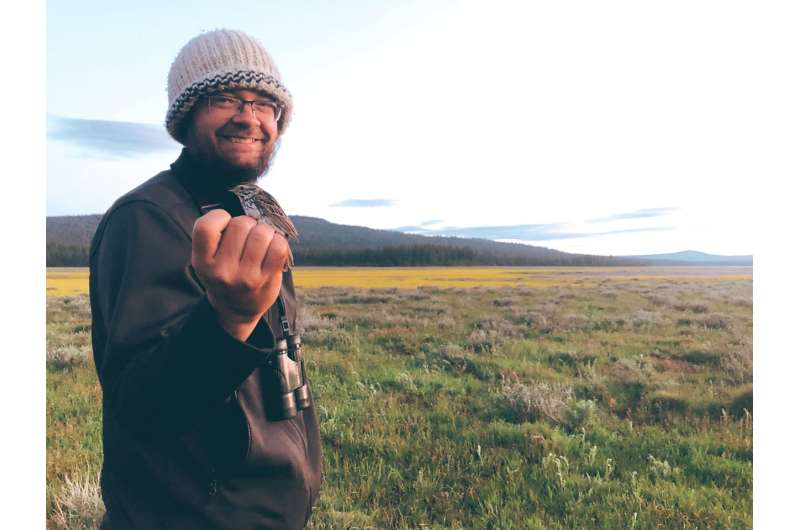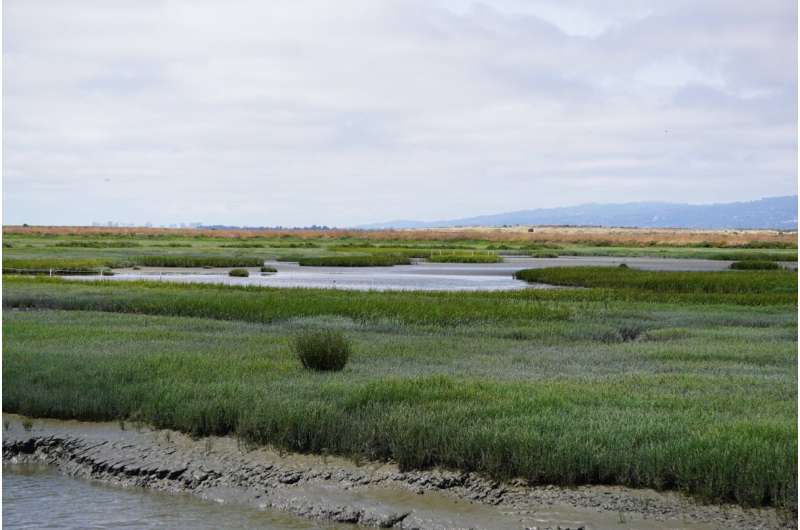This article has been reviewed according to Science X's editorial process and policies. Editors have highlighted the following attributes while ensuring the content's credibility:
fact-checked
peer-reviewed publication
trusted source
proofread
Sparrows uniquely adapted to Bay Area marshes are losing their uniqueness

The temperate climate of the San Francisco Bay Area has always attracted immigrants—animals and humans—that have had unpredictable impacts on those already living in the area.
For the bay's Savannah sparrow, a subspecies that lives in salty tidal marshes, increased immigration of its inland cousins over the past century has definitely been bad news.
A new genomic analysis of Savannah sparrows (Passerculus sandwichensis) from around the state—many of them collected as far back as 1889, their pelts stored in the Museum of Vertebrate Zoology at the University of California, Berkeley—shows that over the past 128 years, the Bay Area's sparrow's adaptation to salt water is being diminished by interbreeding with inland sparrows adapted to fresh water.
The result is stable levels of genetic diversity among coastal Savannah sparrows in Northern and Central California, but a loss of the genetic variants that make them adapted to tidal marshes. This could affect the bird's ability to survive in tidal marshes, where it subsists on saltwater and salty crustaceans, something freshwater birds are ill-adapted to.
The surprise finding, published last week in the journal Global Change Biology, can be explained in part by the steep state-wide decline in tidal marshes, which are wetlands subject to the tidal influx of salty ocean water. The Bay Area has seen a 90% decline in tidal marshland since the 1800s, which has reduced Savannah sparrow populations to the level that interbreeding with immigrants is affecting their unique saltwater adaptation.
"There seem to be increasing levels of gene flow from eastern California into places like the Bay Area, potentially due to the local population becoming a sink where the local breeders can't really produce enough offspring to maintain a population," said Phred Benham, a postdoctoral fellow at UC Berkeley and leader of the study. "So you get the influx of immigrants from another population. The migrants think it's a nice place to stay and try to set up a nest, and there's this opportunity for gene flow to occur into the residents."
That gene flow from sparrows adapted to fresh water into saltwater-adapted sparrows means that the gene variants, or alleles, that allow tidal marsh sparrows to exist in a high-salt environment—by producing larger kidneys, for example—are being lost.
"The inland areas where grasslands remain extensive are producing large numbers of these birds, and they have to go somewhere. And so the Bay Area is a destination," said Rauri Bowie, UC Berkeley professor of integrative biology and curator of birds in the Museum of Vertebrate Zoology (MVZ).
"They're coming in, but they are not adapted to breed in that environment. So they don't do well, and they're introducing maladaptive alleles—freshwater-adapted alleles into saltwater-adapted populations. And some of these coastal populations are endangered. If you go to these habitats, you see lots of Savannah sparrows, but there's something going on underneath the hood that's a lot more complex in these kinds of specialized environments."
A subspecies of special concern
With 17 recognized subspecies throughout North America, Savannah sparrows are commonplace, Bowie said. But the rare subspecies adapted to live in saltwater marshlands are considered threatened. Two occur in California, a northern subspecies (P. s. alaudinus), which is listed by the state as a "species of special concern," and a federally protected southern subspecies called the Belding's Savannah sparrow (P. s. beldingi), which occurs around San Diego and Tijuana, Mexico.
The good news for the northern marshland subspecies, Benham noted, is that tidal wetlands around the San Francisco Bay estuary are protected and growing, potentially allowing coastal Savannah sparrow populations to increase.

"There's a huge amount of tidal restoration efforts underway in the Bay Area, and Savannah sparrows aren't the only ones that depend on this. One of the most critically endangered species in the Bay Area is the salt marsh harvest mouse. There's a lot of federal money going into protecting their habitat, which I think ultimately would benefit the Savannah sparrows," he said. "I think it would be really great to revisit these populations in 10 years to see if this trend is ongoing or if tidal marsh restoration has allowed the locals to reestablish their populations and their dominance."
Continued monitoring of immigrant sparrows, Bowie said, "would give a sense of whether this genetic swamping is continuing and how quickly it's happening. I'd hope that as marshes are restored, that would be mitigated. But we don't know that."
Benham and Bowie, assisted by Jennifer Walsh of the Cornell Laboratory of Ornithology at Cornell University in Ithaca, New York, set out to ask an important evolutionary question: How does habitat loss affect the genetic diversity of animals that occupy that habitat?
"We wanted to test a very simple prediction, that there is reduced genetic diversity associated with habitat loss," Benham said.
For the genetic analysis, Benham obtained DNA samples from Savannah sparrows captured around the state between 1889 and 2017. To get DNA from museum samples, he scraped skin cells from the birds' toe pads. For comparison, he collected blood or tissue samples from living birds he had encountered over the last decade studying Savannah sparrow populations around the Bay Area for his Ph.D. thesis from the University of Montana.
Using a technique called exome capture, he profiled the DNA from 219 individuals and looked for genetic variation in areas of DNA that had previously been identified as important to the saltwater adaptation of marshland sparrows. Some of these adaptations he had discovered himself in studying these Savannah sparrows.
For example, not only are their kidneys larger and thus able to remove more salt from the birds' urea, but their skin is less permeable to water. To make up for a reduced reliance on evaporative cooling, like sweating, to shed heat, their bills have gotten larger, which allows more heat to be lost from the blood flowing through. All these adaptations make up for the fact that songbirds never evolved a solution common to other seaside birds—the ability to excrete excess salt through nasal glands.
The researchers found that the genetic diversity of the Southern California subspecies, the Belding's Savannah sparrow, had declined slightly, but that it had been low even in the 1880s.
Genetic diversity in the Northern California subspecies, however, remained relatively high over the past century, likely due to immigration from inland sites. But this immigration led to gene alleles in regions of the genome involved in saltwater adaptation that were more like the alleles found in freshwater-adapted sparrows.
Bowie noted that the results bear on a major debate in conservation biology today—whether it is wise to bolster small, threatened, inbred populations by breeding them with related populations. In the case of the Savannah sparrow, such outbreeding reduced adaptation to the environment.
"Here, we're showing that if gene flow is happening across these steep environmental gradients, it may have significant negative effects on the local population," Benham said.
"It's actually quite a hard thing to demonstrate the effects of outbreeding," Bowie emphasized. "Having access to the historical series of the museum specimens from before saltmarshes were transformed in the bay to compare with modern birds helps you make the case that outbreeding depression is having a significant effect on the populations. The genetic diversity looks great, but it's masking an outbreeding depression effect."
More information: Phred M. Benham et al, Spatial variation in population genomic responses to over a century of anthropogenic change within a tidal marsh songbird, Global Change Biology (2024). DOI: 10.1111/gcb.17126
Journal information: Global Change Biology
Provided by University of California - Berkeley


















